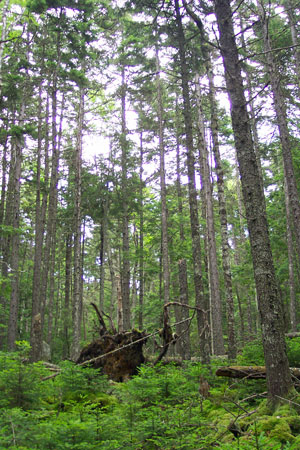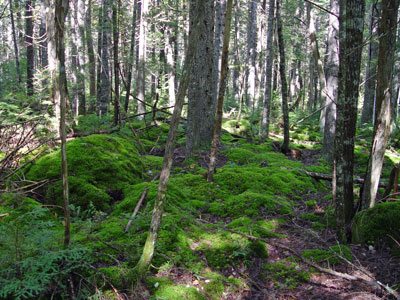DACF Home → Bureaus & Programs → Maine Natural Areas Program → Communities, Plants, and Animals → Natural Community Fact Sheets → Lower-elevation Spruce - Fir Forest
Printer Friendly Fact Sheet - 1.1 MB pdf (Get a free copy of Adobe Acrobat Reader)
Lower-elevation Spruce - Fir Forest
Scientific Name: Spruce - Fir - Broom-moss Forest; State Rank: S5
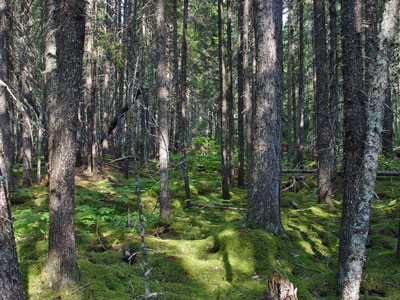
- Community Description
- Soil and Site Characteristics
- Diagnostics
- Similar Types
- Conservation, Wildlife and Management Considerations
- Distribution
- Characteristic Plants
- Associated Rare Plants
- Associated Rare Animals
- Examples on Conservation Lands You Can Visit
Community Description: These closed canopy (>75% closure) forests are dominated by red spruce (>60% cover), typically with few other tree species in any of the layers. Fir is often a minor canopy component (up to 20% cover), particularly in open gaps or in younger stands. Hemlock is occasionally mixed with the spruce in southern or central Maine. The lower layers are sparse or patchy, consisting mostly of tree regeneration. In the sparse herb layer, dwarf shrubs are virtually absent except for spotty lowbush blueberry; herbaceous species cover well under 10% of the ground surface, and usually consist of scattered plants of Canada mayflower, starflower, and bunchberry. Most of the ground surface is bare conifer litter, although at some sites (particularly Downeast Maine), bryophytes may form patchy to full cover. Broom-mosses are the most frequent and abundant bryoids. Back to top.
Soil and Site Characteristics: Sites are typically on hill slopes (lower, middle, or upper) at elevations up to 2200’. Slopes are gentle to moderately steep; aspect is various. The podzolic soils are quite rocky and/or shallow (<40 cm to obstruction) and may be very acidic (pH 4.1-5.2), creating low nutrient conditions. The somewhat xeric to mesic soils range from well drained to imperfectly drained; mottling is often present. Many sites have charcoal in the soil. Back to top.
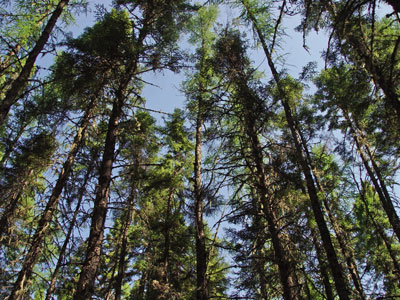
Diagnostics: Red spruce is dominant, and fir is usually present but much less abundant. Regeneration is dense in patches, and herbaceous species are almost absent (< 2% cover, up to 10%). Bryoids are more abundant than herbs and are dominated by broom-moss species. Back to top.
Similar Types: Maritime Spruce - Fir Forests may be very similar, but generally feature more balsam fir, white spruce, and mountain ash and bryoids other than broom-mosses (typically three-lobed bazzania or red-stemmed moss). Montane Spruce - Fir Forests have more herbs and a bryoid layer dominated by feather-mosses. Black Spruce Barrens have patchier canopies and more extensive shrub and herb layers. At higher elevations, this type can grade into Subalpine Fir Forest, where spruce is far less abundant than fir. Back to top.
Conservation, Wildlife and Management Considerations: This is the dominant spruce - fir type in Maine and is therefore extensively harvested and managed. In addition, spruce-budworm and past harvesting have played significant roles in the age dynamics of this type; some studies suggest that many current stands are more even-aged than they would be in the absence of past harvesting. Large (>1000 acres) examples free from human disturbance are scarce. Some areas of high ecological quality, in the hundreds of acres, are known but not necessarily designated as areas reserved from cutting. Almost all are within a landscape of managed forest rather than surrounded by land that has been permanently cleared and converted to other uses.
This community type may be utilized as nesting habitat by a number of coniferous forest specialist bird species such as the sharp-shinned hawk, yellow-bellied flycatcher, bay-breasted warbler, Cape May warbler, blackpoll warbler, northern parula, blackburnian warbler, boreal chickadee, Swainson's thrush, red crossbill, and white-winged crossbill. Back to top.
Distribution: Statewide, characteristic of the Laurentian Mixed Forest Province and New England - Adirondack Province. Extends eastward, westward, and northward from Maine. Landscape Pattern: Matrix. Back to top.
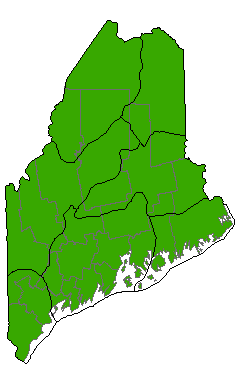

Characteristic Plants: These plants are frequently found in this community type. Those with an asterisk are often diagnostic of this community.
- Canopy
- Balsam fir
- Eastern hemlock
- White pine
- Red spruce*
- Sapling/shrub
- Balsam fir*
- Red spruce*
- Herb
- Balsam fir*
- Red spruce*
- Bryoid
- Dicranum moss
- Red-stemmed moss
- Reindeer lichen
- Three-lobed bazzania
There are no documented examples of rare plants associated with this natural community.
There are no documented examples of rare animals associated with this natural community.
Examples on Conservation Lands You Can Visit
| Example | County |
|---|---|
| Big & Little Squaw Mountain Public Lands | Piscataquis Co. |
| Borestone Mountain Sanctuary | Piscataquis Co. |
| East Nubble, Bigelow Preserve | Somerset Co. |
| Spruce Hill, White Mountain National Forest | Oxford Co. |
| Squa Pan Mountain, Squa Pan Public Lands | Aroostook Co. |
| Tunk Mountain & Wizard Pond, Donnell Public Lands | Hancock Co. |
